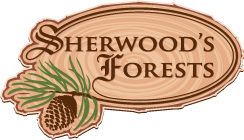Native Cherries
Prunus virginiana var melanocarpa & Prunus pensylvanica
These two cherries are native. Both are covered in clusters of tiny white flowers in early summer. Both have good fall colour. Both produce fruit, peppercorn to pea sized that are mostly pit, but make good jam.
Chokecherry
Choke cherry can be trained into a small tree by selecting a single stem, and ruthlessly suppressing all suckers, but by preference it is a tall shrub, with a bucketful or two of stems, and growing 5-15 feet all and about 1/3 of that wide. Blossoms are tiny, white, and borne in clusters of 20-50. Berries are black, and are very tart. They make wonderful jam and jelly. I've tried one off the bush. Tart isn't the word. These berries have enough puckerpower to turn your tonsils inside out.
(Fall 2008 I harvested half a bucket of chokecherries, separated the seeds from the fruit. Laura made a batch of chokecherry and black current syrup that we enjoy on our pancakes and waffles.)
A mutation of the native chokecherry is sold as the purple leaved Schubert chokecherry.
This is a good wildlife plant. Deer will browse it, birds will nest in it, and will appreciate any berries you don't turn into jelly.
In the fall it has multicolour leaves, predominantly pink, but with yellow and red notes. It is not very noticeable until fall colours hit. It's one of the few shrubs that is a real orange in colour.
It's very drought tolerant.
Recommended as a mid-level shelterbelt species, or for just general interest.
Leaves are about 2 inches long, and have toothed margins. The cherries are small, typically about 4-6 mm with most of the interior being taken up by pit. Both make wonderful jam and syrup, but are quite tart fresh. (Tart! I'll say. Turned my tonsils inside out...) Both are a lovely mix of pink and orange in the fall. Indeed, that's the easiest way to find them in the wild.
Pin Cherry
Overall a hard tree to tell apart from chokecherry. Pin cherry has more clusters of flowers, with fewer cherries in each. Cherries are bright red. Bark is reddish brown. Fall color has more orange, less pink. Not as susceptible to Black Knot.
Common Pests
Both can get aphid infections, but recover quickly if sprayed hard with water. One of those wands with a fan spray makes it easy to reach the underside of leaves. Both are subject to Black Knot fungus. (See lower part of [Stone Fruit][1] section.)
Deer love to nibble on them, but since they are poisonous in quantity the hoof rats just prune them for you. Use them as a distraction.
Natively they are a fringe tree, and understory tree. I think this is mostly due to where birds drop the pits. They do well enough in open country once established.
(Inventory is under Cherries.)
Got something to say? Email me: sfinfo@sherwoods-forests.com
Interesting? Share this page.
Want to talk right now? Call me: (8 am to 8 pm only, please) 1-780-848-2548
Do not arrive unannounced. Phone for an appointment. Why? See Contact & Hours That same page gives our hours of operation.
Back to Top
Copyright © 2008 - 2021 S. G. Botsford
Sherwood's Forests is located about 75 km southwest of Edmonton, Alberta. Please refer to the map on our Contact page for directions.
